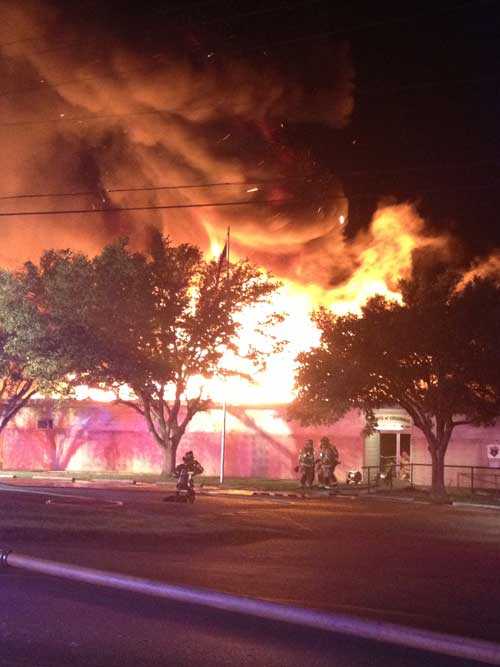Two Career Lieutenants Killed and Two Career Fire Fighters Injured Following a Flashover at an Assembly Hall Fire—Texas
 Death in the Line of Duty...A summary of a NIOSH fire fighter fatality investigation
Death in the Line of Duty...A summary of a NIOSH fire fighter fatality investigation
F2013-04 Date Released: May 20, 2014
Executive Summary
On February 15, 2013, a 36-year-old male career lieutenant (Victim #1) and a 54-year-old male career lieutenant (Victim #2) were killed and two career fire fighters were injured (FF1 and FF2) at an assembly hall fire. At approximately 2320 hours, the fire department responded to a reported assembly hall fire with flames visible. Upon arrival, fire was observed by the fire department burning at the roof level in the area of the A/B corner. After arriving units conducted 360-degree walk-arounds, offensive interior operations were employed to stop the fire’s progression. The first interior attack crew (Victim #1 and his probationary fire fighter) advanced a hoseline toward what they believed was the seat of the fire. After discovering the fire in the A/B corner and flowing water on it, Victim #1 and his probationary fire fighter both became low on air. Victim #1 told his probationary fire fighter they needed to exit. Both began following the hoseline out, with the probationary fire fighter in front. However, for an unknown reason, Victim #1 was unable to follow the hoseline and he became separated from his probationary fire fighter. Victim #1 radioed for help. The probationary fire fighter called out to Victim #1 but did not receive an answer nor did he hear any alarms. He then continued following the hoseline to the outside. At this time, an engine company (Victim #2, FF1, and FF2), which was designated as the rapid intervention team (RIT), was immediately deployed into the structure to locate Victim #1. The RIT followed the hoseline in and was able to locate Victim #1, who was responsive. While dragging Victim #1 toward the exit, the RIT was caught in a flashover. Following the flashover, all of them were quickly removed and transported to local hospitals. Unfortunately, Victim #1 did not survive his injuries. FF1, FF2 and Victim #2 were transferred to a regional burn center for extensive treatment where Victim #2 later succumbed to his injuries.

Incident scene.
(Photo courtesy of local police department.)
Contributing Factors
- Nonsprinklered commercial building
- Risk management principles not effectively used
- High-risk, low-frequency incident
- Fire ground strategy, tactics, and ventilation
- Rapid fire progression
- Fire burned and spread undetected above the ceiling
- Crew integrity
- SCBA air management
- Fire ground communications
- Flashover.
Key Recommendations
- Fire departments should use risk management principles at all structure fires.
- Fire departments should ensure that incident commanders and fire fighters understand the influence strategy and tactics (e.g., ventilation) may have on fire behavior and fire fighter safety and consider whether traditional firefighting tactics are appropriate.
- Fire departments should ensure that an established incident management system on a fireground is appropriate and effective as it relates to that specific incident.
- Fire departments should ensure that a complete situational size-up is conducted on all structure fires.
- Fire departments should ensure that crew integrity is properly maintained by face-to-face contact or radio contact when operating in an immediately dangerous to life and health (IDLH) atmosphere.
The National Institute for Occupational Safety and Health (NIOSH), an institute within the Centers for Disease Control and Prevention (CDC), is the federal agency responsible for conducting research and making recommendations for the prevention of work-related injury and illness. In 1998, Congress appropriated funds to NIOSH to conduct a fire fighter initiative that resulted in the NIOSH “Fire Fighter Fatality Investigation and Prevention Program” which examines line-of-duty-deaths or on duty deaths of fire fighters to assist fire departments, fire fighters, the fire service and others to prevent similar fire fighter deaths in the future. The agency does not enforce compliance with State or Federal occupational safety and health standards and does not determine fault or assign blame. Participation of fire departments and individuals in NIOSH investigations is voluntary. Under its program, NIOSH investigators interview persons with knowledge of the incident who agree to be interviewed and review available records to develop a description of the conditions and circumstances leading to the death(s). Interviewees are not asked to sign sworn statements and interviews are not recorded. The agency's reports do not name the victim, the fire department or those interviewed. The NIOSH report's summary of the conditions and circumstances surrounding the fatality is intended to provide context to the agency's recommendations and is not intended to be definitive for purposes of determining any claim or benefit.
- Page last reviewed: November 18, 2015
- Page last updated: October 15, 2014
- Content source:
- National Institute for Occupational Safety and Health Division of Safety Research


 ShareCompartir
ShareCompartir